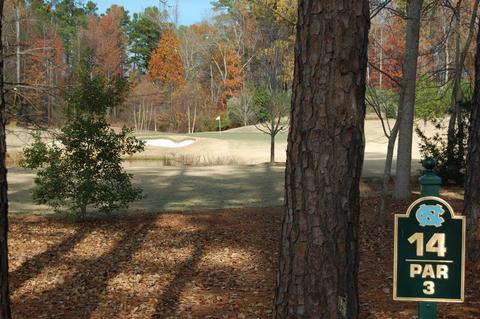
College towns like Chapel Hill, NC, offer excellent golf, such as the University of North Carolina's Finley course.
The most expensive and least expensive houses in college towns in the U.S. are about $1.5 million apart, according to a recent press release from the real estate firm Coldwell Banker. The median price for a 2,200 square-foot 4-bedroom, 2 ½-bath home in Palo Alto, CA, the home of Stanford University, is pegged at $1.68 million. Near Ball State in Muncie, IN, the same size home will cost you just $150,000.
The Coldwell Banker survey, the press release indicated, took some inspiration from a famous game-ending play 25 years ago in November when Stanford and the University of California played their annual football game. Current Coldwell sales agent Kevin Moen scored the winning touchdown for Cal on the final play of the game, threading his way through the Stanford marching band that had run onto the field to celebrate a likely victory just seconds before an improbable defeat.
With our son now at college and essentially forced to live off campus from his sophomore year on, I've considered the practical and financial implications of buying a house near his campus in Virginia. Coldwell Banker's CEO, Jim Gillespie, says I'm not the first to think about it.
"Real estate professionals have been doing this for years," Gillespie said in the press release. "Once their child is able to live off-campus, they do so in the family-owned home with classmates paying rent as roommates. Over time, the home appreciates in value and the family can keep it or sell it with the proceeds going toward the college payments."
That same logic applies to anyone looking for a vibrant place to live, with good golf nearby. College enrollments rarely fluctuate, except upwards, which builds stability into the local real estate market. Prices in the markets below haven't quite taken the hits in prices of other markets with less predictable economies.
All the southern college towns we have reviewed are listed in the Coldwell Banker survey. Prices below are calculated by Coldwell for zip codes popular with middle managers working in local corporations. Prices from one zip code to the next within an individual town may vary significantly. Median home prices listed here were calculated in October 2007:
Columbia, SC (U of South Carolina), $199,000
Knoxville, TN (U of Tennessee), $202,000
Winston-Salem, NC (Wake Forest), $229,000
Durham, NC (Duke), $230,000
Raleigh, NC (NC State), $238,000
Austin, TX ((U of Texas), $243,000
Athens, GA (U of Georgia), $249,000
Atlanta, GA (Georgia Tech), $324,000
Charlottesville, VA (UVA), $374,000
Chapel Hill, NC (UNC), $388,000
You will find the full list of college towns and prices at the Coldwell Banker web site.
Page 861 of 1030